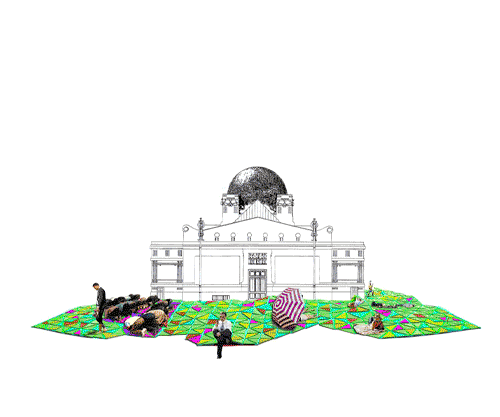
Date
Summer 2007
Place
Vienna, Austria
Medium
Open space installation involving ski-polls and outdoor carpets in wood
Design context
Produced within an exhibition of individual outdoor projects in Secession, Vienna / / July 15 – October 06, 2007 / Curated by Barbara Holub and Anna Mayer
Idea, Concept and Design
Azra Akšamija
Architecture, Realization, and Conceptual Collaboration
Adelheid Pretterhofer/ Arquitectos, Vienna
Project Supervisor, Coordinator, and Conceptual Collaborator
Christina Nägele / Secession, Vienna
Thanks to
Participants of the KUNSTMOSCHEE program and carpet weavers; Family Aksamija, Omar Al-Rawi, Saeed Arida, Amina Baghajati, Patrick Baumueller and Severin Hofmann, Khadija Z. Carroll, Vivien Chapeau, [ dy:na'mo ], Wolfgang Haas, Mouhanad Khorchide, Daniela Kobel, Susan Kraupp, Anneka Lenssen, MA42, Sudabeh Mortezai, Nasser Rabbat, Christian Rathner, Irvin C. Schick, Susanne Schindler, Doris Schmid, Dieter Spath, Deniz Turker, project sponsors, and above all the team and the managing board of the Secession.
Sponsors
Project produced by Secession, Vienna and with a partial support by the Council for the Arts at MIT. Material sponsoring by Kodak Austria.
Kunstmoschee [Art-Mosque]
The KUNSTMOSCHEE is
an interactive installation located on the external grounds of the
Secession from July 20th through
This architectonic
rug-landscape consists of 120 individual modules that together create an
ornamental pattern. While the rugs can be used for daily prayer, they
also provide an opportunity for relaxing or seating during the larger
scheduled events. KUNSTMOSCHEE becomes thus a space for gathering and
communication between visitors with different cultural needs.
KUNSTMOSCHEE-events include lectures, discussions, a carpet-weaving
workshop, and screenings of contemporary Iranian films. This
accompanying
program aims to
question the distorted and politicized representations of Islam in
While the program of the KUNSTMOSCHEE asks for a mutual enrichment of Islamic and non-Islamic cultures in Europe, the colourful rugs provide for this a shared territory. They were created by supervised groups of over forty Viennese from various age groups who were invited to participate in carpet-weaving workshops on the basis of their professional, religious, or cultural backgrounds as well as personal interests. The individual rugs will be distributed among their weavers and the program-participants at the closing ceremony to the exhibition. In this way KUNSTMOSCHEE has not only been created through a community effort, but it will also become the collective property of the Viennese.